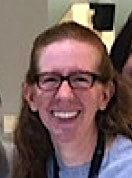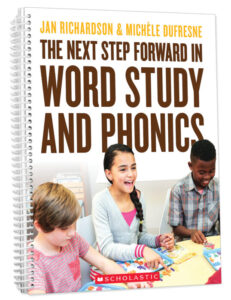Stepping Forward in Word Study and Phonics
The Next Step Forward in Word Study and Phonics
By Jan Richardson and Michèle Dufresne
(Scholastic, 2019 – Learn more)
Reviewed by Beth Hassinger

Well, I’m the kind of reader who had the plaid phonics books in school. I could complete the pages to read my CVC words, then my CCVC words and so on.
However, I also am the kind of reader that had to perform through round robin reading. I didn’t read as fast as the other kids and did not know how to apply my phonics skills to my reading. This left me very anxious trying to rehearse my part while others were reading. It wasn’t until I had to teach spelling patterns that it all started to click.

If you are familiar with The Next Step Forward in Guided Reading, you will recognize how this companion book is organized. As in many books, the Introduction lays out what you will find in the book and how the book is organized. I found in this chapter a chart on page 9 called the “Approaches to Teaching Phonics.” This chart explains how various phonics programs create their scope and sequence which was new learning for me.
Chapter 2 describes ten activities that will be referenced throughout the book to be used to support and teach word study or phonics concepts within guided reading. If you have read the aforementioned book, you will be familiar with many of them. Recommendations are made for what text levels various activities are appropriate for.
I will warn readers that while I believe this book has considerable value, many of the tools to complete the activities are not provided. The author’s mention that you can purchase the materials from Pioneer Valley Press, but if you are looking for a complete package in both activities and materials, this is not it. The remainder of the book is organized by stages of reading development from pre-A to fluent.
At Every Stage
As you work with readers at various stages, you will find that the authors outline goals at each stage. There are a variety of assessment options with forms are provided in the appendix as well as lesson plan templates. An appealing feature are the sample lessons that are included. The number supplied is dependent on the stage the student is in and is only meant to be a scaffold until you become familiar with the structure and can create your own.
Other features that you will find are video links to watch various components in action, activities for independent practice, ways to support those who are struggling, and common questions teachers have. Considerations are also made for English learners at each stage.
The Big Picture
I found this book to be very beneficial in the work that I do as a reading specialist. It is organized in such a way that I will be able to differentiate and imbed phonics and word study skills with a variety of literacy contexts. It would be helpful to any educator who is looking to assess students’ levels of phonics proficiency and teach based on the learning needs you’ve identified.
It would also be beneficial if you are not comfortable with or want to strengthen your phonics or word study instruction, especially if your school is not providing you with a curricular resource. While you will need to invest in magnetic letters and picture cards, the materials needed are minimal and you may already have them available to you in your classroom.
Phonics is the foundation on which reading and writing are built. It does not stop, but rather transitions into word study. Students need to be taught how these skills can be applied to reading and writing. Using this resource, you will be able to do just that.
Beth Hassinger works as a reading specialist at a K-5 building in a suburb north of Chicago, IL. Having just finished a second Master’s in Educational Leadership, she looks forward to a leadership position in the future. Having not read much as a child, she is continually looking for ways to engage readers and invite them to see the wonder reading is. You can find her on Twitter @SL_Reader.

































